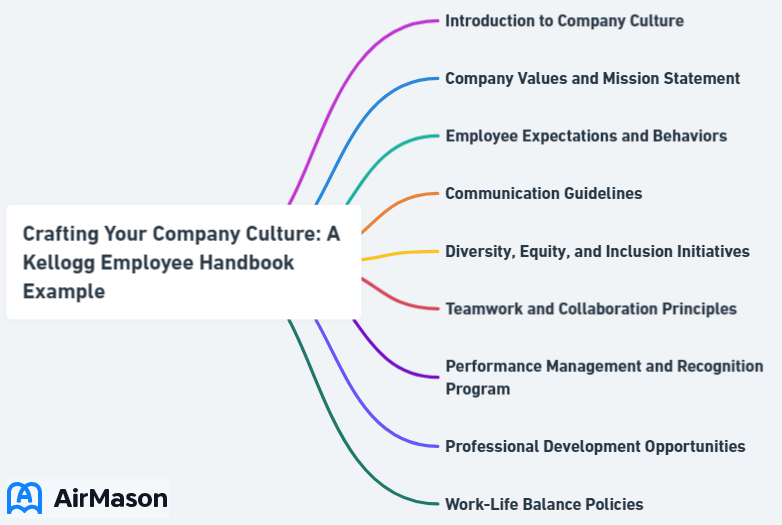
Imagine building a company culture that fosters employee engagement, productivity, and satisfaction, just like the renowned Kellogg company. The secret ingredient for achieving this is a well-crafted employee handbook that serves as a guide for employees and sets the foundation for a thriving workplace. In this blog post, we will explore how to create an effective employee handbook inspired by the Kellogg employee handbook example, focusing on company values, policies, benefits, and legal compliance.
Key Takeaways
- Establish company values and culture, communicate policies and procedures, outline employee benefits & perks.
- Implement legally compliant Equal Employment Opportunity policy, At-Will employment disclaimer to address harassment & discrimination.
- Promote open communication with regular checkins/feedback, encourage conflict resolution, track leaves of absence properly with updated handbook distribution/acknowledgement
Creating an Effective Employee Handbook: A Kellogg-Inspired Guide
An employee handbook is a critical communication resource for both employers and employees, outlining the company’s purpose, history, strategy, mission, vision, policies, procedures, and benefits. The creation of a successful employee handbook, such as the one by Kellogg’s, relies on the clear articulation of company values and culture, transparent communication of policies and procedures, and comprehensive outlining of employee benefits and perks.
Establishing Company Values and Culture
Defining and communicating company values and culture in the employee handbook is of utmost importance. Here are some steps to follow:
- Establish the mission statement.
- Collect input from key stakeholders.
- Give employees a voice and explain the reasons behind the company’s values.
- Encourage a sense of ownership and alignment.
Behavior consistent with the company’s values and culture is expected, promoting:
- Respect
- Integrity
- Collaboration
- Innovation
Transparently articulating the company culture in the employee handbook sets clear expectations and rules for employees, cultivates a sense of belonging and consistency, and promotes a positive working environment.
Including company values and culture in the employee handbook provides a wealth of information for employees, sets high standards and expectations, ensures fairness and equal treatment, and fosters a shared company culture that augments productivity.

Communicating Policies and Procedures
Transparently communicating company policies and procedures is paramount to guarantee employee comprehension and compliance. Transparent communication of policies can foster trust and improve workplace culture. To achieve this, follow these steps:
- Present policies and procedures in advance.
- Provide opportunities for employees to review and ask questions.
- Utilize face-to-face communication for greater understanding.
By following these steps, you can ensure that your employees fully understand and comply with company policies and procedures.
An anti-harassment policy should clearly communicate that harassment, including sexual harassment and unlawful harassment, will not be accepted, and those who partake in it will face severe disciplinary action or termination. The policy should also explicitly state that retaliation against a person who has made a harassment allegation is illegal.
Outlining Employee Benefits and Perks

A comprehensive description of employee benefits and perks in the employee handbook is key to draw in and retain high-performing employees. Companies typically offer the following employee benefits and perks:
- Medical coverage
- Dental insurance
- Vision insurance
- Life insurance
- Paid time off
Top companies like Kellogg offer a range of employee benefits and perks, including:
- Early finish Fridays
- Inclusive policies
- Health, life, dental, vision, long-term disability, and temporary disability insurance
- Employee discounts on various products and services
Legal Compliance and Best Practices

An employee handbook plays a vital role in legal compliance, conveying relevant state law and federal employment laws, including applicable law, and providing a layer of protection against possible legal claims for the company. Including an at-will employment disclaimer, an equal employment opportunity policy, and addressing harassment and discrimination are essential elements for a legally compliant employee handbook.
Equal Employment Opportunity Policy
An equal employment opportunity policy is instrumental in fostering a diverse and inclusive work environment. The policy should clearly state that the organization upholds the belief that all persons are entitled to equal employment opportunities and should list all the protected classes or indicate that the organization does not discriminate against employees protected under various federal and state laws.
Implementing an equal employment opportunity policy in the workplace offers several advantages, such as:
- Encouraging diversity
- Providing growth opportunities
- Improving organizational reputation
- Increasing employee involvement
- Eliminating prejudice and discrimination
The policy facilitates diversity by ensuring that employment decisions are based on merit and qualifications, rather than factors such as race, gender, ethnicity, sexual orientation, or marital status.
At-Will Employment Disclaimer
An at-will employment disclaimer clearly outlines that the employment relationship is at-will, meaning either the employer or the employee can terminate the employment at any time, for any reason, provided it is not illegal or in violation of any protected rights. This disclaimer helps to establish the understanding that the company has the right to make changes to the terms and conditions of continued employment without notice and without liability, thus providing a level of protection for the company against potential wrongful termination claims.
To ensure the effectiveness of the at-will employment disclaimer, it should be prominently displayed at the start of the handbook, presented in bold uppercase letters.
Addressing Harassment and Discrimination
Developing a safe and respectful workplace necessitates the addressing of harassment and discrimination through transparent policies and procedures. An effective anti-harassment and discrimination policy should include:
- A clear prohibition against harassment and discrimination
- Definitions and examples of what constitutes harassment and discrimination
- Consequences for engaging in harassing or discriminatory behavior
- Procedures for reporting incidents
- Assurance of confidentiality and protection against retaliation for reporting
- A commitment to conducting thorough and impartial investigations of reported incidents.
By including an anti-harassment policy that outlines what constitutes harassment and discrimination, employees can better understand the company’s expectations and prohibited behaviors, promoting a safe and inclusive work environment.
Promoting Open Communication and Feedback

Promotion of open dialogue and feedback between employees and management is key to nurturing a positive workplace environment. The aim of an open-door policy is to promote transparency and trust between employees and managers. It allows staff to bring forth any issues and have them addressed in a quick and effective manner. Some effective strategies to promote open communication in the workplace include:
- Demonstrating honesty, respect, and investment in employees’ goals
- Conducting regular check-ins with employees
- Incorporating open communication into company culture
- Gathering employee feedback and acting on it
Encouraging Employee Feedback
Fostering a feedback culture within a company offers numerous advantages by empowering and motivating employees, increasing engagement, establishing trust between leadership and employees, and providing valuable data for improvement. To ensure employees feel comfortable voicing their concerns and suggestions, it is important to cultivate psychological safety, facilitate open dialogue, establish feedback channels, demonstrate leadership through example, and cultivate a culture of trust.
Companies that have successfully cultivated a culture of employee feedback include:
- Airbnb
- Capital One
- Publix Super Markets
- Microsoft
- Workday
- Chegg
- RingCentral
- HubSpot
- Concentrix
- Elsevier
- LexisNexis Legal & Professional
Conflict Resolution
Employing conflict resolution strategies is necessary to sustain a harmonious work environment. Effective strategies for addressing conflicts in the workplace include:
- Avoiding conflicts when possible
- Competing to assert your position when necessary
- Accommodating and compromising to find a middle ground
- Collaborating with others to find mutually beneficial solutions
- Encouraging open and honest communication between parties involved in the conflict.
Incorporating conflict resolution into the employee handbook can help employees successfully navigate conflicts in a fair and consistent manner. Management plays an integral role in fostering open communication and conflict resolution by creating and executing policies and procedures that ensure fairness, respect, and desirable outcomes for all parties involved.
Implementing Leaves of Absence Policies

Detailing the need to implement leaves of absence policies is crucial for upholding a healthy work-life balance and complying with legal mandates, including local laws. Proper tracking and documentation of leaves of absence ensure compliance with relevant laws and regulations.
Mandatory and Optional Leaves
Drawing a distinction between mandatory and optional leaves of absence along with their corresponding requirements is vital, especially when a family member is involved. The Family and Medical Leave Act (FMLA), one of the federal laws, provides up to 12 weeks of protected leave, while other labor laws and company policies may grant additional forms of mandatory leave.
Companies may provide optional leaves of absence such as bereavement leave, sabbatical leave (paid or unpaid), and optional personal leave, in collaboration with an other third party.
Tracking and Documentation
Keeping track of and documenting leaves of absence is key to comply with relevant laws and regulations. Accurate and up-to-date records must be maintained, documentation must be organized and secured, the duration of leave time must be tracked, and employee well-being must be prioritized.
To effectively manage leaves of absence, it is advisable to:
- Utilize a centralized portal or system for reporting and managing both paid and unpaid leaves.
- Keep precise and current records of employee leave and absences.
- Implement a clear attendance policy and ensure employees are aware of it.
By following these steps, you can ensure that your organization is compliant and that employee leaves are properly managed.
Regularly Updating and Distributing the Employee Handbook
Consistent updates and distribution of employee handbooks are critical to keep employees updated and to meet legal obligations. The employee handbook should be revised at least annually by the human resources department to guarantee its accuracy in reflecting the current policies and procedures of the human resources department.
Reviewing and Revising the Handbook
Regular assessment and modification of the handbook are required to ensure its continued accuracy and relevance. When reviewing and revising an employee handbook, it is important to take into account the following factors:
- Legal compliance
- Company policies
- Clarity and understanding
- Regular review
- Consistency
Distribution and Acknowledgment
Adequate distribution and recognition of the employee handbook are crucial to verify employee comprehension and acceptance. Here are some steps to follow:
- Disseminate the revised handbook to all employees.
- Require employees to acknowledge receipt and understanding of the updates.
- Provide a platform for employees to ask questions or seek clarification on the updated handbook.
By following these steps, you can ensure that employees have read and understood the updated handbook.
Xcel Energy Employee Handbook Example
In the comprehensive Xcel Energy Employee Handbook Example, employees gain valuable insights into the organization’s policies, procedures, and values. This handbook serves as a crucial resource, outlining the expectations and responsibilities that come with being part of the Xcel Energy team. Covering a diverse range of topics, from workplace conduct to safety protocols, the handbook is designed to ensure that every employee has a clear understanding of the company’s standards. With user-friendly language and accessible information, the Xcel Energy Employee Handbook Example plays a pivotal role in fostering a positive work environment and promoting a culture of collaboration and excellence.
Summary
In conclusion, crafting an effective employee handbook, inspired by Kellogg’s example, is a vital component in fostering a thriving company culture that promotes employee engagement, productivity, and satisfaction. By focusing on establishing company values and culture, communicating policies and procedures clearly, outlining employee benefits and perks, and maintaining legal compliance, organizations can create a solid foundation for success and employee well-being.
Frequently Asked Questions
What is the code of conduct for Kellogg’s?
At Kellogg’s, we commit to treating each other with fairness and respect, providing our consumers with safe and tasty foods, competing vigorously and ethically, and partnering with those who share our values.
What are Kellogg’s K values?
Kellogg Company (K) has established an ethical performance culture, with its ‘Global Code of Ethics’ based on values of integrity, accountability, passion, humility, simplicity and success. Through upholding these values, the company’s aim is to create better days and a place at the table for everyone through its trusted food brands.
Is code of conduct separate from employee handbook?
The code of conduct is an essential part of the company’s employee handbook, which may include communications policies, social media and internet usage policies, as well as rights and expectations of employees. The Code of Conduct is one of the most important parts of the Employee Handbook, so a template is often used to help communicate expectations clearly. Yes, the code of conduct is separate from the employee handbook.
What are the key components of a Kellogg-inspired employee handbook?
A Kellogg-inspired employee handbook should communicate company values and culture, clearly outline policies and procedures, include employee benefits and perks, and ensure legal compliance.
How can an employee handbook promote open communication and feedback in the workplace?
An employee handbook can promote open communication and feedback in the workplace by encouraging employee feedback, implementing conflict resolution strategies, and fostering a trusting and psychologically safe environment.
Important Disclaimer:
The article presented here does not serve as a representation of the company’s actual employee handbook mentioned in this article.
Our discussions and insights regarding employee handbook are based on assumptions about what may be considered significant in the companies’ policies. These assumptions are drawn from available information and industry knowledge. Readers are advised that the content provided is for informational purposes only and should not be construed as an exact reflection of any company’s official policies or procedures. For precise and accurate details regarding a company’s employee handbook, individuals should refer directly to the company’s official documentation or consult with appropriate representatives.
Please be aware that the content on this page has been generated by using artificial intelligence language models and may contain errors, inconsistencies, or outdated information. It is provided as-is without any warranties or guarantees of accuracy. We strongly recommend using this content as a starting point for further research. We disclaim any liability for damages or losses resulting from the use or reliance on this content.